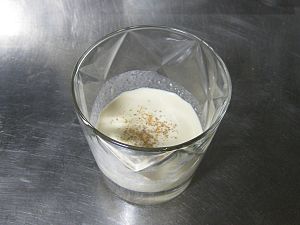HistoryWhat would the holiday season be without Eggnog? Chances are that you or someone in your household will buy a carton of this sweet dairy drink sometime between now and 2012. In celebration of National Eggnog month, here are some fun facts about this holiday staple.
- The origins of eggnog are somewhat of a mystery, although there are several theories about how it can to be the modern drink we know today.
- One theory is that eggnog is a descendant of posset, a 14th century drink popular in Medieval Europe that was made with hot milk.
- Beverages similar to eggnog were popular with the aristocracy in Britain primarily because the required ingredients were expensive and less available to the lower classes.
- Another theory combines egg, for the beaten eggs the drink contains, and nog, a shortened version of noggin which was a Middle English word used to describe a small wooden mug used to serve alcohol.
- Many theories place the origination of eggnog in the American colonies.
- One of the more popular theories makes egg and grog, a drink made with beaten eggs and rum, the father of modern day eggnog.
- Colonists turned to Caribbean rum, which was readily available and inexpensive, in order to avoid the high taxes on other types of alcohol.
- The easy access to dairy products and inexpensive rum in the colonies made this beverage available to everyone, not just those in the elite classes.
- By the 18th century, the term eggnog was in use to describe a similar beverage to the one sold today, although traditionally, eggnog was served as a hot beverage.
The Basics
- Eggnog can have either a milk or cream base and is made with sugar and beaten eggs.
- Most eggnog also contains some kind of alcohol like rum, brandy, or whisky.
- The most common spices sprinkled atop a cup of eggnog are cinnamon and nutmeg.
- Eggnog can also be infused with flavors, like vanilla or spice.
- In addition to adding alcohol to their eggnog, some people also add eggnog as a substitute for milk or cream to their tea or coffee.
- Popular in the U.S. and Canada during the holiday months, eggnog is generally only commercially available in grocery stores from mid-November to early January.
- Eggnog sold in stores in the U.S. does not contain raw eggs.
- Non-tradition versions of eggnog can be found in grocery stores that use low-fat milk, skim milk, soy products, or other alternative ingredients.
Other Tidbits
- Records from the kitchen at Mount Vernon show that George Washington was a fan of eggnog and often served his version, which included rum, rye whisky and sherry, to visitors.
- Early Americans didn’t seem to mind what kind of alcohol was included in their eggnog, just so long as it was included.
- When made into a custard, eggnog can be used to make ice cream.
- Because of the risk of salmonella, most modern recipes for home-made eggnog recommend using pasteurized eggs.
- According to the FDA, the alcohol in eggnog is not an effective way to kill germs found in raw eggs.
- One 4 ounce cup of eggnog has 170 calories, 10 grams of fat, and 70 mg of cholesterol.
Do you like to make homemade eggnog during the holiday season? If so, here are some recipes we thought you may enjoy! If you have a favorite eggnog recipe you’d like to share, we’d love to hear from you!


